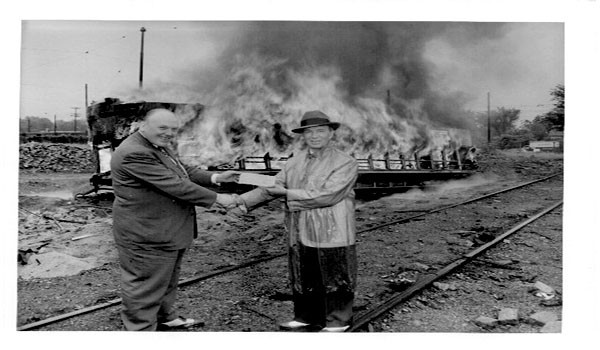Public Transportation Needs to Take A Step Backward

Photo Courtesy of Hennepin County Library
Businessman James Towley and Fred Osanna,head of the Twin Cities Rapid Transit Company, shake hands and exchange money as the last of the Minneapolis streetcars burns behind them, in 1954.
October 1, 2013
By now, South students are familiar with city buses, as they have replaced school buses as students’ transportation. While the effectiveness and environmental benefits of buses cannot be denied, there could be much better ways to get around the city.
Once upon a time, Minneapolis, St. Paul, and the surrounding areas were connected by a streetcar system. This system was so effective that you could board a streetcar in Stillwater, ride all the way to Deephaven, Excelsior, or Tonka Bay, and board a boat to take you to your next destination. Needless to say, this system connected the Twin Cities in an highly efficient manner.
However, only one streetcar remains of this elaborate network. By 1954, it was decided that buses would be a cheaper option than streetcars, and they were scrapped.
Although it’s unlikely that we’ll ever achieve a streetcar system again, Minneapolis and St. Paul can learn from this model. The two light rail lines have already taken big steps towards a connected mode of transportation, as they provide an extremely fast, cheap mode of transport for many of the busiest parts of the city. But is it too late to build a sophisticated train system like those of Chicago, or New York?
We’ve lost our chance at a public transportation system on the same scale as the subways. The streetcars should never have been taken down, as destroying them created opportunities for communities to develop based on a car culture.
The streetcar system was dismantled with a substantial amount of influence from companies who would greatly benefit from the replacement of streetcars with highways, like tire companies. This meant that the city planning that went into Minneapolis and St. Paul after 1954 created an urban center based on highways, not public transportation systems.
Because of this, we can never again achieve the same efficiency of public transportation. This also caused a great disparity in the way that infrastructure did develop: wealthier neighborhoods were given efficient transport, while poorer neighborhoods were overlooked, underfunded, or completely destroyed to make way for highways, like in the case of the predominantly African-American Rondo neighborhood in St. Paul.
Today we are seeing these same issues play out in a different area. A new light rail line is being debated, which would travel to Eden Prairie. However, there has been much delay concerning conflict from the wealthier neighborhoods it would pass through. Richer neighborhoods, or suburbs like Edina, have more sway in where the train will go and because they don’t want to have a train in their neighborhood, the line will definitely be delayed and may never come to fruition.
Today, there are still ways to improve the public transportation system. Last Tuesday, a CIty Council committee voted to build a streetcar line along Nicollet and Central Avenues. This represents a step towards a more connected transportation network, and also shows how city planners are taking inspiration from systems that have worked in the past. If we continue with this mindset, we may have a better chance at building efficient public transportation in the future.




